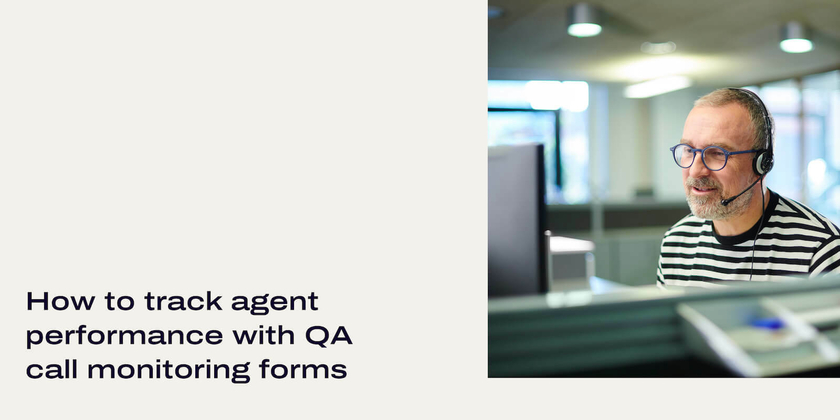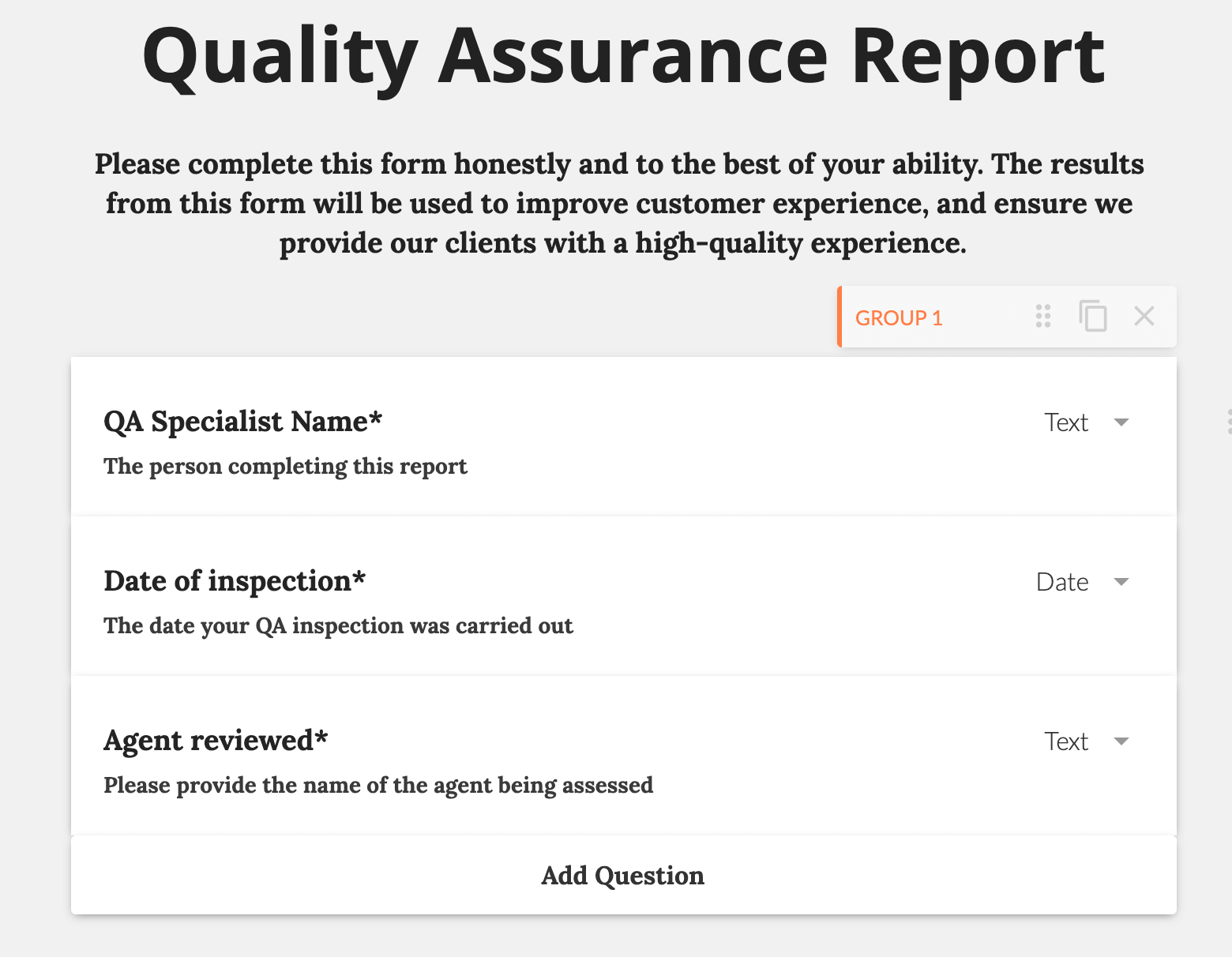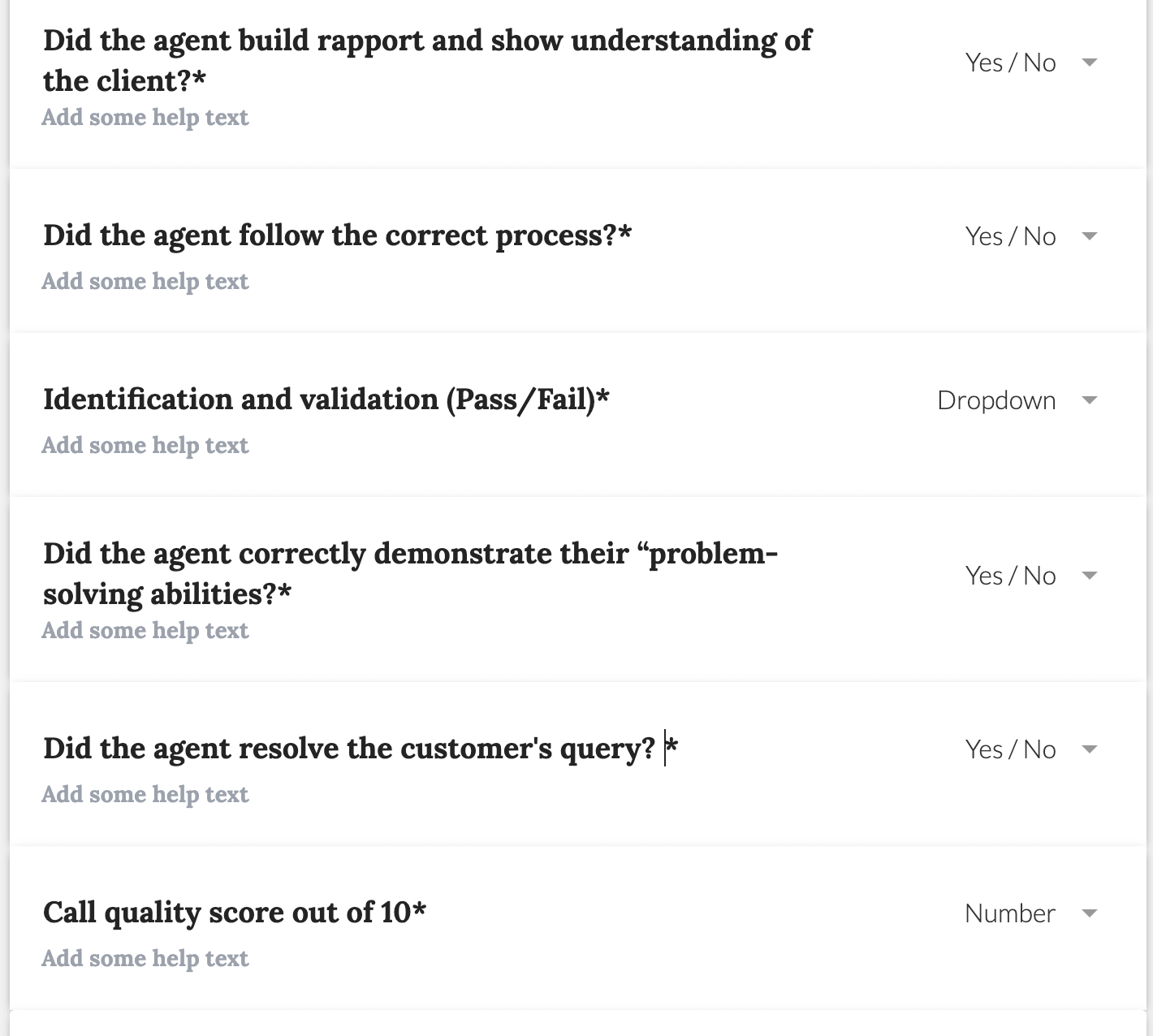
October 12, 2021
For a business to succeed, it needs to maintain high customer service call standards. Regular monitoring can help you achieve consistently high-quality interactions with your callers.
Critical to this process is quality assurance (QA). QA is essentially the act or process of confirming that a business' quality requirements are being met. Companies that can get customer service QA right can positively differentiate their brands from competitors, reduce costs and waste, and win more referrals.
Businesses that rely on contact center or call center agents often use QA to measure the performance of their reps. Call recording, regular training and call monitoring forms all play a role.
In this post, we'll focus on call monitoring forms as a simple and effective way of tracking agent performance within your organization. Read on to find out more about what exactly this tool is and how you can use it:

Skip ahead if you like:
- What is a QA call monitoring form?
- What skills should be measured?
- How to get the most out of a QA monitoring form
- How to build an effective QA monitoring form in 6 steps
- Questions to include in a QA call monitoring form
What is a QA call monitoring form?
QA call monitoring form is a structured document that enables contact center quality assurance analysts to assess the performance of an agent. Agent performance is measured against pre-defined criteria set out by the company, based on conversations between agents and customers.
Monitoring forms can be used to:
Identify struggling agents
Ensure that agents are conducting calls according to predefined criteria
Evaluate the way that employees handle customer calls
Guarantee adherence to service standards
Why are monitoring forms so helpful for assessing agent performance in call centers?
Monitoring forms provide insightful feedback that wouldn’t otherwise be available. You can use them to assess skills, inform training programs, reward performance, and identify trends.
In contrast to traditional analytics tools, forms also provide you with insights into where agents are struggling. Forms provide oversight on any number of elements of call quality including diverse areas such as how the agent greeted the client, how they offered help, the way they verify customer accounts, their adherence to protocol, and their call handling skills.
Ultimately, monitoring forms can provide valuable insights to help you improve your customer satisfaction (CSAT) score. By improving user experience, you can foster high standards and positive relationships with clients.
What skills should be measured?
The main metrics to track in any QA report include:
Soft skills
Process
Compliance
Outcomes
Each one can help build a picture of your agents’ performance for you to assess what’s working well and what needs to be improved. Revisiting your metrics regularly lets you identify new areas for improvement across your business.
Soft skills
"Soft skills" are some of the most important areas for you to measure as part of your QA monitoring process. As your direct link to customers, skilled contact center or call center agents should be able to facilitate friendly, professional interactions with callers and deliver the service as defined by you.
Some of the most important soft skills for call center agents to master include:
Communication – the ability to deploy the right vocabulary at the right time, choose suitable (and sensitive) words and phrases, and answer customer questions concisely
Showing patience and empathy when dealing with difficult callers
Active listening – the ability to anticipate customer needs and facilitate their questions
Positivity – the ability to remain calm and helpful regardless of the difficulty of the call
Detailed knowledge of your products and services.
Processes
Call center agents have a defined set of processes they need to work through to meet the needs of the business. Processes are valuable for reducing call handling time and ensuring callers get the result they’re looking for. A QA monitoring form can help you assess whether these processes are being followed by your agents.
Some key call center processes include:
Asking employees to sign non-disclosure agreements (NDAs) so that they do not share information relating to your technical systems, customer information or business information with any third party
Creating an attendance policy that states the length of employee shifts, how they can increase their base pay, and what policies they must follow if they skip work
Drafting a dress code that specifies what employees must wear to work and various exemptions, such as jewelry or head coverings
Creating a drugs and alcohol policy (with the help of an attorney)
Drafting A/V consent forms that give your business permission to monitor employee calls and use them for evaluation purposes
Asking job candidates’ permission to conduct background checks before hiring them to your team
Setting out your ID badge policy and what happens if an employee loses their badge
Following processes can benefit your business in multiple ways:
It provides colleagues with consistent processes and structures that enable your organization to run more smoothly by reducing the frequency of unexpected events and aligning agents with your enterprise’s goals.
It ensures a consistent, high-quality service for customers because employees are following the optimal scripts during every call.
It reduces organizational liability risks. Employees feel comfortable because they are following safe and proven methods when interacting with customers.
Compliance
Compliance is a crucial part of business activities, especially when personal data is involved. In the simplest sense, compliance means following a set of rules that have been outlined.
For call centers, compliance in certain areas is an absolute necessity, as there could be legal ramifications for businesses that fail to maintain compliance with official regulations. Compliance in call centers needs to be observed to:
Protect customer data
Protect credit card data
Meet legal requirements on cold calling
QA call monitoring lets you assess whether agents are demonstrating compliance with all the necessary regulations. A failure to meet compliance regulations could mean that an agent needs further training, or compliance procedures need to be made more explicit.
Outcome
Measuring outcomes is vital for monitoring the overall performance of your call center handlers. Your customer service teams are crucial to achieving positive business outcomes, with businesses that have a ‘customer service mindset’ enjoying revenues of 4-8% higher than others.
Your outcomes should assess whether soft skills, process and compliance were met, assessed in a dedicated area of your QA monitoring form.
There are, of course, many possible outcomes of a call. Which you care about depends on the type of business you run.
Some examples of outcomes metrics include:
Number of calls made
Length of time of calls
Were certain expectations and targets met?
Did the agent follow processes?
Did the agent meet all compliance standards?
Did the agent follow up with the customer at the end of the call?
For data collection purposes, you can stamp calls with account codes. When an agent finishes a call, they type codes matching the client outcome. So, for instance, they might press 1 if they confirm a sale, or 2 if they successfully schedule a consultation.Companies can then display call outcome information on wallboards displaying live counts of each outcome type. Where outcomes are ambiguous, systems can record calls and then forward them to managers for review. Firms can also create new categories for different types of uncertain outcomes.
How to get the most out of a QA monitoring form
In order for QA forms to be as effective as possible, and to give the most accurate results, it is important to know how to get the best out of them. Here are a few tips to keep in mind to optimize QA monitoring forms.
How regularly should QA monitoring forms be sent out?
While the frequency of QA forms issuance can vary between businesses, certain times are better for sending out forms than others. For instance:
During different stages of the training and induction process
When changes are made to your products or services
In advance of performance reviews
In relation to your performance tracking and analysis reports
Regular performance monitoring can help identify key issues and priorities for your business. You can also track trends over time to see if you are improving or not.
Let your customers define quality standards
According to W Edwards Deming's theories on management, quality should be based on standards as perceived by the customer, but set out by the business. So any QA metrics you use should reflect what callers want and align with company objectives.
By setting out a business-wide process you enhance uniformity. In turn, this ensures that customers receive the same quality of support from all advisors, generating trust in your brand.
Be fair and reasonable when completing scores
Your agents can only provide resolutions for situations within their control. If they’re not provided with the correct or complete information and are unable to resolve a query, you’ll need to monitor the steps they took in trying to help the caller.
For instance, instead of recording whether an agent made a sale, you could record ownership statements. A customer might call to ask a question like “has my order shipped?” and then the agent might say something like “I will check the status of your order now. Do you have your order number?”
In this example, the agent is doing precisely what they should do: taking ownership of the situation. The customer then has confidence that they are dealing with their issue.
Monitor basic courtesies
As more millennials enter the workforce, the incidence of politeness is declining. According to Intellegentics, a QA analytics company, only around six percent of customer service calls taken by this age group featured either a “please” or a “thank you” when asking customers for information. However, customers still expect politeness, so leaving these words out of the conversation can damage brand reputation.
And according to Intelligentics, use of common courtesies is at a lower level than at any other point in history. In light of this, firms with the right knowledge and monitoring can instruct employees to use politeness to differentiate themselves from the competition.
Think beyond average handle time
The average handle time (AHT) can be a good indicator of your agent’s performance, but not in isolation. There could be identifiable causes as to why some calls take longer than others to be resolved - and not always through the fault of the agent.
Try investigating extreme-length calls - those more than two standard deviations above the mean. Find out what went wrong and why. Performing case studies of longer calls can often provide more useful insights than AHT alone. Often you will discover patterns that you can address in training to prevent long calls in the future.
Work with your agents
Your agents are the people doing the work, so they are often best placed to advise on the questions that need to be included in a QA form. Get their help in establishing how much weight should be given to certain areas in line with their experiences of handling calls and their interactions with customers.
Allowing your agents to complete a self-assessment helps them feel more empowered and a part of the process. While they may be more likely to sell themselves short, seeing their actual QA scores from an assessor could be just what they need to stay motivated. It also helps them take pride in their work if they’re having to regularly look at their own performance.
How to build an effective QA monitoring form in 6 steps
After establishing the key principles of a QA monitoring form, you can then set about creating the right form for your business. Although it is possible to find pre-made monitoring forms online, it is much better to take a bit of extra time and make one specifically for your business.
If you have never created a form before, it can be tricky to know where to start. Here are a few tips and tricks for building an effective QA monitoring form.
1. Identify your goals
To get a better understanding of what you are trying to achieve, host stakeholder focus groups. Invite people from all departments in your organization (such as finance, sales, marketing and customer service) to take part in discussions on what you want your call center to achieve.
Each team or group will have a different set of priorities. Your goal is to ensure that all objectives are on the table, ready for consideration. Goals may include:
Improving agent performance
Better facilitating the onboarding process
Ensuring proper channel-specific behaviors (such as improving email etiquette)
Better understanding the digital customer experience
2. Convert your goals into KPIs
Once you set your goals, you need to convert them into measurable key performance indicators (KPIs). These will be set based on certain behaviors displayed by your agents during their interactions with customers.
Common KPIs to measure include:
The use of appropriate language to open and close calls
Statements that exhibit positivity and a willingness to help customers
Maintaining full control of the call
Avoiding the use of slang, bad language or jargon
Talking at the pace of the customer
Avoiding interrupting the caller without good reasons
Using empathetic statements where required
3. Create your form
Creating your QA call monitoring form should be done in a way that allows assessors to carry out their work in a structured manner. If possible, construct it so that it follows the typical flow of a call, allowing elements such as greeting, product knowledge, customer interactions, problem-solving and compliance to be followed easily.
4. Assign weights to your scoring
Next, convert your points of assessment into scores. You want to place more weight on behaviors that reflect KPIs that are more important for your goals. If weights are incorrect, any coaching you perform will not have the real-world benefits on customer experience that you want.
Going beyond KPIs, you can also include:
Bonus questions that reward exceptional agent performance
Compliance-related questions that trigger a ‘fail’ if they’re not met
5. Decide on your scoring method
There are different ways of scoring your QA Scorecard or call monitoring form. They could be as simple as yes/no questions, or feature more of a ranking system (good/average/poor, etc.).
You will then need to decide how your scores are reported. Meaningful ways of displaying your data could include:
Points totals
Percentage scores
Pass/fail
Defect rates
You will need to tailor your reporting to the needs of your business. Metrics should highlight issues and provide reps with meaningful feedback.
You will also need to create a scoring guide that details how each behavior is scored. This should be shared with various people across the organization, including agents, assessors, trainers, and others.
6. Determine the correlation between your data and goals
The last step is to correlate customer satisfaction and QA data. By determining how your quality data meets your strategic goals, you can decide which behaviors are the most important – something that can influence the training you provide your agents.
In general, the more important the metric, the stronger the correlation with customer satisfaction. So, for instance, you might find that saying “please” and “thank you” is highly correlated with customer satisfaction ratings, but that resolving calls in less than 10 minutes is not.
Learning which behaviors have the most impact on customer satisfaction can help you marshal your resources more effectively. If politeness is what callers value, then training should focus on that.
Questions to include in a QA call monitoring form
The effectiveness of your QA call monitoring form is dependent on the questions you ask. Careful question planning will ensure you get the information you need to be able to maintain quality standards within your organization.
Unlike your typical form or questionnaire, some questions are more suitable than others for your QA form. Closed questions are more common in a QA monitoring form than open-ended questions. Closed questions help provide answers that are easy to quantify, allowing you to provide a straightforward and relevant score.
Closed-ended questions also allow for assessors to carry out their evaluations quicker. It can be difficult to answer every question accurately if you’re having to take down notes during a conversation.
However, having open-ended questions as a follow-up, or a space to provide comments alongside a closed question, could provide some context for scoring and to be able to deliver helpful feedback to agents:

Soft skills questions
Did the agent display active listening skills?
Did the agent build rapport and show understanding of the client?
Was the agent’s tone and pitch appropriate to the mood of the call?
Did the agent summarize the follow-up plan?
Was the agent professional at all times?
Process questions
Did the agent follow the correct process?
Did the agent follow the compensation process?
Did the agent terminate the call correctly?
Did the agent update the notes in the CRM case?
Compliance questions
Pass/Fail: Identification and validation
Pass/Fail: Identifying and handling vulnerable customers
Pass/Fail: Seeking permission to look at personal information
Outcome questions
How well did the agent meet their “greeting” goals?
How many “soft skills” did the agent successfully demonstrate?
Did the agent correctly demonstrate their “problem-solving abilities?”
How well did the agent follow all of your processes?
Was the agent fully compliant with company policies?
Did the agent follow up with the customer at the end?
Did the agent resolve the customer's query?
Monitoring call center performance is an important process for any business or organization. By tracking performance, you can gain valuable insights into the performance of your business and whether your activities meet the needs of your customers. Quality assurance can be a difficult process to initiate, but once the process is in place, it will help you get the best out of your teams, and the best out of your business too.
Jo Roque is the Customer Success Lead for Paperform. As the CSL, Jo works closely with her team in outlining policy and procedures, troubleshooting issues and building rapport with Paperform's users. Jo has a background in various customer success roles from onboarding to training. Outside of work, Jozella enjoys hanging out with her family, mountain biking and adventuring with her dog.





